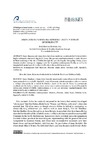Identificador persistente para citar o vincular este elemento:
https://accedacris.ulpgc.es/jspui/handle/10553/70483
| Campo DC | Valor | idioma |
|---|---|---|
| dc.contributor.author | Estévez-Saá, José Manuel | en_US |
| dc.date.accessioned | 2020-02-22T08:55:10Z | - |
| dc.date.available | 2020-02-22T08:55:10Z | - |
| dc.date.issued | 2016 | en_US |
| dc.identifier.issn | 2386-8635 | en_US |
| dc.identifier.uri | https://accedacris.ulpgc.es/handle/10553/70483 | - |
| dc.description.abstract | James Stephens and James Joyce have been mentioned as referents for Caitriona Lally’s highly acclaimed debut novel, Eggshells (2015). The present contribution intends to study this new brilliant rendering of the city of Dublin through the eyes of allegedly ‘changeling’ Vivian, whose Joycean creative musings on language serve her to portray contemporary Dublin, as well as to imaginatively project portals to other worlds where she can feel more at ease. | en_US |
| dc.description.abstract | James Stephens y James Joyce han sido mencionados como referentes de la aclamada ópera prima de Caitriona Lally, Eggshells (2015). El presente artículo pretende estudiar esta nueva y brillante plasmación de la ciudad de Dublín a través de los ojos de Vivian (supuestamente cambiada por las hadas al nacer), cuyas cavilaciones creativas joyceanas en torno al lenguaje le sirven para retratar el Dublín contemporáneo, a la vez que proyectar imaginativamente otros mundos en los que se pueda sentir más a gusto. | en_US |
| dc.language | spa | en_US |
| dc.relation.ispartof | Philologica canariensia | en_US |
| dc.source | Philologica canariensia [ISSN 2386-8635], n. 22, p. 137-144 | en_US |
| dc.subject | 550510 Filología | en_US |
| dc.subject | 570107 Lengua y literatura | en_US |
| dc.subject.other | Contemporary Irish literature | en_US |
| dc.subject.other | Flâneuse | en_US |
| dc.subject.other | James Joyce | en_US |
| dc.subject.other | Caitriona Lally | en_US |
| dc.subject.other | Eggshells | en_US |
| dc.subject.other | Dublin City | en_US |
| dc.subject.other | Ciudad de Dublín | en_US |
| dc.subject.other | Literatura contemporánea irlandesa | en_US |
| dc.title | James Joyce’s Echoes in Caitriona Lally’s Portrait of Dublin City | en_US |
| dc.type | Article | en_US |
| dc.type | info:eu-repo/semantics/article | en_US |
| dc.identifier.doi | 10.20420/PhilCan.2016.107 | en_US |
| dc.investigacion | Artes y Humanidades | en_US |
| dc.type2 | Artículo | en_US |
| dc.description.notas | Walter Benjamin is one of the critics who dealt at large with the figure of the flâneur in his study Charles Baudelaire: A Lyric Poet in the Era of High Capitalism. 2 The novel is presided by a quotation from W. B. Yeats about this fantastic creature, taken from the introduction to Fairy and Folk Tales of the Irish Peasantry (1888): “Sometimes the fairies fancy mortals, and carry them away into their own country, leaving instead some sickly fair child… Most commonly they steal children. If you ‘over look a child’, that is look on it with envy, the fairies have it in their power. Many things can be done to find out if a child’s a changeling, but there is one infallible thing –lay it on the fire… Then if it be a changeling it will rush up the chimney with a cry” (2008, 5). | en_US |
| dc.identifier.ulpgc | Sí | es |
| dc.description.esci | ESCI | |
| dc.description.dialnetimpact | 0,0 | |
| dc.description.dialnetq | Q3 | |
| dc.description.dialnetd | D6 | |
| dc.description.erihplus | ERIH PLUS | |
| item.fulltext | Con texto completo | - |
| item.grantfulltext | open | - |
| Colección: | Artículos | |
Visitas
169
actualizado el 15-mar-2025
Descargas
140
actualizado el 15-mar-2025
Google ScholarTM
Verifica
Altmetric
Comparte
Exporta metadatos
Los elementos en ULPGC accedaCRIS están protegidos por derechos de autor con todos los derechos reservados, a menos que se indique lo contrario.
